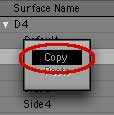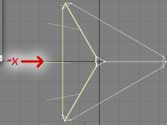 |
The new UVs will show up on the map, sized to fill the whole square.
Cut the polys using the keyboard, and paste them right back in. This will unweld the points, so the polys that make up this surface can be manipulated separately from the polys that make the other surfaces. Select the surface once more.
Now we have to place the polys in the correct position on the map. Since this is a die, the numbers have to be in exactly the right places. To make sure that they are, set one of your viewports to Bottom, Texture mode. You will be able to see the numbers on your die when you do this.
You will notice that the numbers are backwards; that is, they are mirror images of what they should be.
To fix them, of course, you need to go to Map > Texture > Flip UV Point Map. When the requester appears, Flip U. (Remember, U flips right to left, V flips top to bottom.) Presto! The numbers are in the correct orientation. (You can also see, since this map isn't symmetrical, that Flip UV Point Map really does flip the map.)
|



















